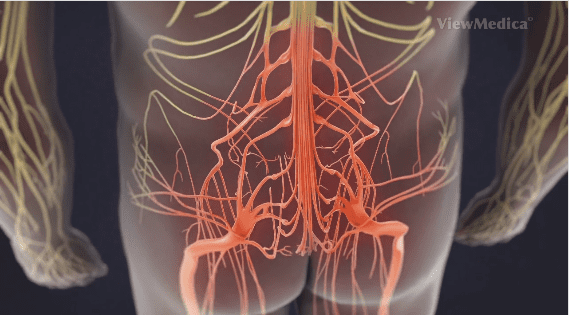Lumbar radiculopathy simply means a radiating pain caused by the irritation of a nerve. Lumbar means that it originates in your lower back, shoots down through your buttocks, down the back of your leg and even as far down as your foot. It is a deep pain that accompanies activities such as standing, walking or sitting. When the pain follows the path of the nerve in the lowest vertebrae in your back or sacrum it is called sciatica. Other types of nerve pain come from compression of the nerves in the higher lumbar vertebrae. This pain is felt at the front of your thigh and radiates down to your shin.
Besides pain, you may feel tingling and numbness, weakness and impaired reflexes. Though there is pain in your back because of the compressed nerve, the worst pain might be in in your leg.
What Causes Lumbar Radiculopathy
The cause of lumbar radiculopathy can be a herniated disc. In these instances, the spongy disc that cushions the space between the vertebrae ruptures and presses on the nerve, which causes pain. This is the most common reason for people to suffer from the condition.
Another cause for lumbar radiculopathy is when the hole the spinal cord passes through narrows for some reason. The most likely causes are arthritis or bone spurs. Diabetes can cause lumbar radiculopathy, as can trauma to the nerve root. This includes past surgeries. Doctors can make a diagnosis of the condition through imaging technologies such as MRI and CT scans. These technologies show the narrowed spinal canal or the disc impinging on your spinal nerve.
Treatment
Most physicians recommend that lumbar radiculopathy be treated conservatively for at least a month and half to two months. This type of treatment can include pain and anti-inflammation medicines, spinal injections and physiotherapy. If this doesn’t ease your pain, surgery is an option. Surgery is also an option before the six to eight week time table if the pain is so severe that it interrupts your daily activities. Surgeries include:
- Laminectomy: With laminectomy, a piece of the vertebra called the lamina is removed to widen the hole through which the spinal cord passes. Sometimes laminectomy is enhanced by spinal fusion. Fusing the vertebral joints together prevents the narrowing of the spinal canal, or stenosis from recurring. You will probably spend two or three nights in the hospital after laminectomy then spend the rest of your recuperation at home.
- Discectomy or microdiscectomy: In these surgeries, the disc that is impinging on the nerve is removed. Microdiscectomy differs from discectomy in that it is a minimally invasive procedure. The doctor operates through tiny incisions and a series of tubes that are inserted around the area of the spine that needs treatment. These surgeries can be performed by either a neurosurgeon or an orthopedic surgeon. With microdiscectomy, you only need to spend a few hours in the medical facility before you can go home, though some patients stay overnight. You are able to resume your normal activities without pain soon after your operation.
Enjoy an active body and a happier life…at the Advanced Spine Center Make an Appointment today!










